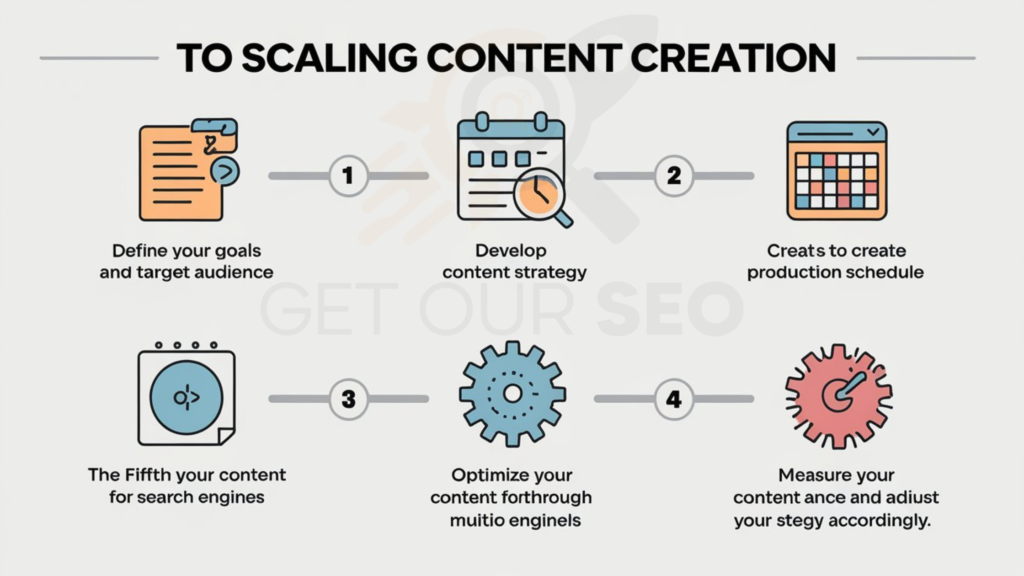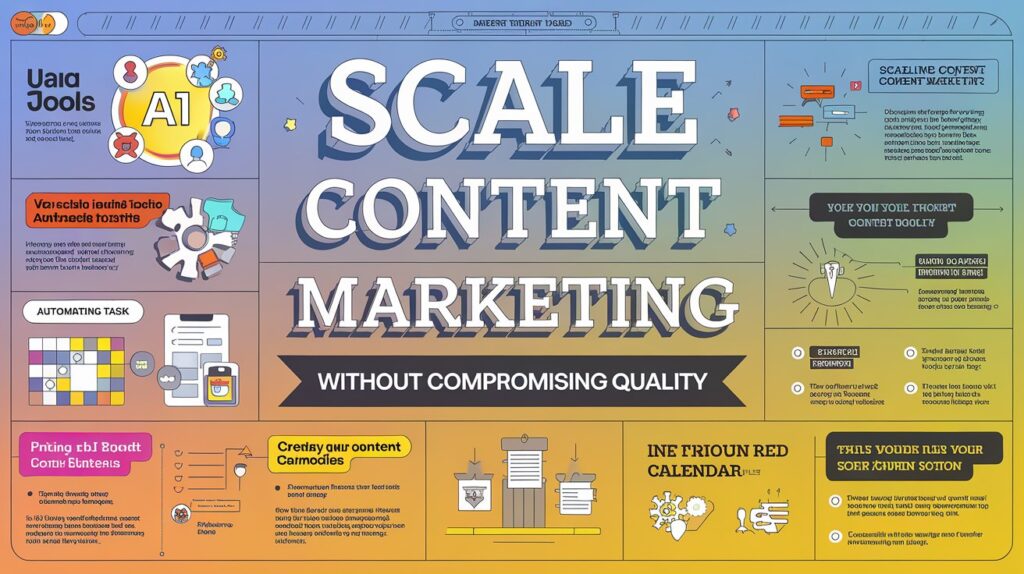Scaling content isn’t just about publishing more—it’s about publishing smarter. Our proven framework helped us publish 300+ articles in six months, grow organic traffic by 30%, and increase revenue by 77%. Ready to revolutionize your content game? Let’s dive into the nitty-gritty of content scaling.

Why Scaling Content Matters
Scaling your content isn’t just a vanity metric; it’s a growth multiplier. When done right, it can:
- Enhance brand visibility.
- Bring in consistent organic traffic.
- Reduce dependency on paid advertising.
- Create a compounding effect on revenue.
Sounds exciting? Let’s make it happen.
Step #1: Break Your Writing Process into Tiny Steps
Creating content can feel overwhelming, like staring at a blank canvas. But when broken down into small, manageable steps, the process becomes more approachable.
Here’s how we do it:
- Research keywords and topics.
- Draft a brief.
- Outline the structure.
- Write the first draft.
- Edit and refine.
- Add visuals and optimize for SEO.
- Publish and distribute.
By focusing on your strengths (e.g., writing or strategy) and delegating the rest, you’ll save time and ensure quality.
Step #2: Create a Laser-Focused Content Calendar
A content calendar is your production blueprint. It organizes timelines, tasks, and deadlines to keep everything running smoothly.
Tips for an Effective Calendar
- Use tools like Monday.com, Notion, or Google Sheets.
- Break down content creation into queues: writing, editing, designing, developing, and distribution.
- Include specific deadlines and owners for each task.
Step #3: Plan Content 6-9 Months in Advance
A reactive content strategy is a recipe for chaos. Instead, plan your content calendar for at least six months.
Benefits of Advanced Planning
- Reduces last-minute stress.
- Improves seasonal relevancy.
- Allows for batching tasks like keyword research.
Use tools like Semrush’s Topic Research to identify trends and map out topics in advance.

Step #4: Draft Crystal-Clear Content Briefs
Think of content briefs as the GPS for your writers. They provide direction, context, and the “why” behind each piece.
Key Elements to Include:
- Primary and secondary keywords.
- Target audience and search intent.
- Suggested content angle and structure.
- SEO opportunities (like featured snippets).
Step #5: Outline Every Article Before Writing
Freestyle writing might work for Hemingway, but for the rest of us, outlining is a lifesaver.
Benefits of Outlining:
- Keeps your content organized.
- Ensures no key points are missed.
- Speeds up the writing process.
Step #6: Equip Your Team with Resources
Give your team the tools they need to succeed:
- Content Guidelines: Define tone, structure, and SEO principles.
- Checklists: Highlight must-haves for drafts.
- Evaluation Tools: Score drafts based on set criteria to ensure consistency.
Step #7: Bring in Rock-Star Editors
Good editors are like polishers—they turn good drafts into gold. Hire editors who:
- Understand your niche.
- Have an eye for detail.
- Can ensure SEO and brand voice consistency.
Step #8: Hire Domain Experts or Connect Writers with SMEs
To truly scale quality, pair knowledgeable writers with subject matter experts (SMEs). SMEs bring real-world experience, while writers add storytelling finesse.
Step #9: Conduct Paid Trials Before Onboarding Writers
Test your writers with limited paid trials to evaluate their skills, professionalism, and adaptability. Look for improvements between drafts—it’s a sign they’re learning your style.
Step #10: Repurpose Content Like a Pro
Why create content once when you can reuse it in multiple formats?
Examples of Repurposing:
- Blog post → Social media carousel.
- Article → YouTube video.
- Guide → Email newsletter series.
Step #11: Optimize Continuously
Content isn’t a “set it and forget it” game. Regularly update and refine your content based on:
- Engagement metrics.
- SEO performance.
- Reader feedback.
Tools and Tech to Streamline Scaling
Leverage tools to make scaling easier:
- Keyword Research: Semrush, Ahrefs.
- Content Management: Notion, Monday.com.
- Editing: Grammarly, Hemingway.
- Analytics: Google Analytics, Search Console.
Common Mistakes to Avoid When Scaling
- Compromising on quality: Quantity without quality is a waste.
- Skipping SEO basics: Even great content won’t perform without optimization.
- Neglecting updates: Outdated content can harm your credibility.
Conclusion: Your Roadmap to Success
Scaling your content isn’t about working harder; it’s about working smarter. With the right systems, tools, and team, you can achieve explosive growth without sacrificing quality. So, what’s your next step?
FAQs
1. How do I maintain quality when scaling content?
Focus on hiring experts, creating clear guidelines, and investing in editors to ensure consistency.
2. What tools are best for content scaling?
Platforms like Semrush, Monday.com, and Grammarly streamline research, management, and editing.
3. How long does it take to see results from scaled content?
It varies, but most strategies show noticeable growth in 3-6 months.
4. Can small businesses scale content effectively?
Absolutely! Start small, document your process, and use freelancers or SMEs for support.
5. How often should I update my content?
Revisit key pieces every 6-12 months to ensure relevance and accuracy.
Welcome to the GetOurSEO.com Blog, your hub for expert insights and actionable tips in digital marketing. Explore strategies across SEO, PPC, content marketing, and social media to enhance your online presence.
Why Choose GetOurSEO?
We provide tailored strategies to align with your business goals, supported by a skilled team that ensures measurable results and exceptional ROI. Offering a full suite of services, including SEO, market analysis, and social media management, we prioritize customer satisfaction and long-term partnerships. Trusted by businesses worldwide, including in India, the UK, the USA, and Australia, we’re here to help you thrive in the competitive digital landscape.
Discover how GetOurSEO can take your business to new heights.


